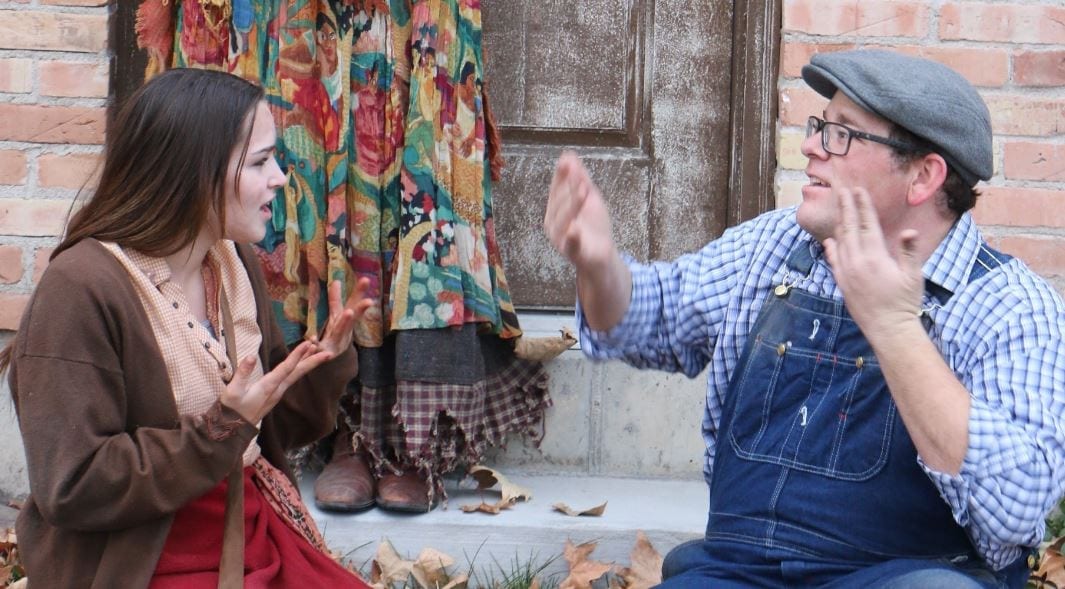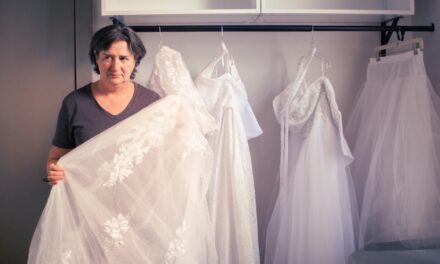OREM — Although Mother Hicks is the second in a trilogy of plays written by Suzan Zeder, it is not necessary to have seen the prequel, The Taste of Sunrise to see this play. The script is stronger than the last Zeder play that Utah Valley University produced, The Milk Dragon. Unfortunately, with an under-rehearsed cast, poorly executed technical elements, and uninspired direction force Zeder’s story to languish in this lackluster production.

Show closes January 30, 2016.
Mother Hicks tells the story of an abandoned girl who bounces from family to family in the town of Ware, Illinois, during the Great Depression. The child (only called Girl in the play) yearns for the family she never knew. Her only clue to their identity is a scrap of a blanket, embroidered with the initials I.S.H. that she was found with as a baby. Meanwhile the town of Ware is abuzz with gossip about Mother Hicks, a woman who lives nearby and whom the townspeople blame for the adverse events of their lives: cows ceasing to give milk, the untimely death of children, and crop failures. As she searches for a place in life, Girl’s life collides with Mother Hicks’s. Serving as an observer and commenting on the action is Tuc, a deaf man who is an outsider, like the titular Mother Hicks.
Leading the cast as Girl is Emma Eugenia Belnap, who portrays her character’s yearning for love, acceptance, and family with a sweet pathos. Her concern for the blanket scrap and her bitterness towards others who had cast her out made the character complex and multidimensional. As the only character who links together the two acts, Girl dominates the play, and Belnap was able to carry burden of the lead role well. Likewise, McKell Petersen’s Mother Hicks had an Aunt Eller-ish folksy charm and tough love that made her a lovable outsider. As Mother Hicks mourned the losses she had experienced in life, Petersen showed how her character’s losses had made her into a wise and strong woman and a suitable role model for Girl.

Top: McKell Petersen as Mother Hicks. Bottom left: Emma Eugenia Belnap as Girl. Bottom right: Matt McGill as Tuc.
Unfortunately, the rest of the cast was not strong enough to bring make the play into an interesting evening of theatre. Many actors seemed uncomfortable in their roles, and the pauses between lines indicates that they could use at least three more run-throughs before the dialogue feels like a natural conversation. Worst in this regard were Kaylee Sue McGhghy and Daniel Bunker. As Alma Ward and Hosiah Ward, respectively, the two are supposed to play characters who have had a lengthy marriage together. But their interactions were stiff and showed little familiarity with one another. I wanted to stop the play, get on stage, and introduce the two to one another. Similarly, the group scenes (such as the confrontation between the townspeople and Mother Hicks in the second act) were stilted. Again, the characters on stage did not feel like they had known each other for years, as would be expected in a small, rural town where many people knew one another.
Compounding the problems with the acting were some fundamental flaws in John Newman‘s directing. Few of the scenes had much energy in them, and some of the actors seem to be doing their own thing on stage (such as Garrett Smit‘s propensity to wander around the stage and gesticulate unnecessarily). Movements, line deliveries, and actions in almost every scene were lackluster because all seemed to occur because “this is what the director told me to do,” and not because they were the logical consequences of the characters’ psychology and how they react to the scene. As a result, none of the characters seemed to have any existence once the actor stepped off the stage.
Like the directing and the acting, most of the technical elements of the play were unimpressive. Only the costumes, designed by Scott Edward Twitchell, were commendable. Twitchell understands that a Depression-era setting does not have to mean “drab,” and the costumes, such as the sophisticated dress that Erica Whalen wore as folklorist Faye Cooper-Cole, were aesthetically pleasing and served to strengthen the character development in a production that sorely needed it. The set (designed by Stephen Purdy), however, was much less impressive. Consisting of a dirty cyclorama (onto which a sky was simulated through the lighting design), three telephone poles, and an ugly cart that shifted position via a movable platform (instead of its own wheels, for some baffling reason), the set was an eyesore that failed to hold my interest. Yet, the worst technical element was Jaron Kent Hermansen and Laicey M. Giddy-Brown’s lighting design. Setting aside the missed cues (which is often a result of equipment malfunctions or stage management problems), the lighting design detracted from the story far more than it enhanced it. Unfocused lights resulted in poorly lit actors. Additionally, the limited color palette failed to liven up the monochromatic set and contributed to the subdued feeling of the acting.
Were I not bound by UTBA rules to stay for the entire show, I would have left Mother Hicks after the first half-hour. The few redeeming qualities of the play could not compensate for the pervasive low quality of so many other parts of the show. To Zeder’s credit, the story was interesting enough that I am curious about the other plays in her trilogy. I just hope that, the next time Utah audiences encounter the denizens of Ware, it will be through a stronger director, cast, and design team.





